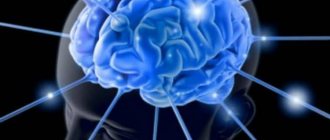Trigger - what is it?
Translated from the source - “trigger”, pistol trigger. And its action, like the flight of a bullet, is instantaneous. And after the shot is fired, the situation always changes, and radically.
The term is widely used in psychology, medicine, marketing, physics; triggers are a common word among programmers and gamers, because each topic has a specific trigger that changes the entire subsequent, seemingly calculated algorithm of behavior.
D – trigger
The D-flip-flop has 1 information input (D-input). There are only synchronous D-flip-flops. The state of the information input is transmitted to the output under the action of a clock pulse (input C).
D flip-flop transition table
| C | D | Q(t) | Q(t+1) | Explanations |
| * | Information storage mode | |||
| * | 1 | 1 | ||
| 1 | * | Information recording mode | ||
| 1 | 1 | * | 1 |
If input D is “1”, then upon arrival of the clock pulse Q = 1. If input D is “0”, then Q = 0.
Types of triggers
In terms of the quality of their impact on a person, triggers can be both positive and negative. An external stimulus causes certain emotions, under the influence of which a person performs an action.
A positive trigger, for example, is the smell of ice cream that you ate as a child, and when you catch it, you feel good, but you don’t understand why.
The quiet cry of a child instantly wakes up a soundly sleeping mother, although she does not react to the sound of a loudly screaming TV and does not wake up.
Negative triggers cause a strong surge of emotions that can lead to inappropriate behavior. “I don’t know what came over me, why I bought seven boxes of matches...” But just a person remembers the times of shortages under the USSR and after a news program in which a cheerful presenter announced that another match factory had been closed, he was so scared that he bought up supplies...
Undesirable consequences of triggers
Most of the triggers we encounter are neutral and have little or no impact on our quality of life. But some may cause unwanted effects, such as:
- Loss of control over emotions
.
Under the influence of a trigger, you can do a bad thing or offend a person. - Susceptibility to other people's influence
.
Even an adult, in certain circumstances, can perceive another person as a mentor and be influenced by him. - Spontaneous purchases
.
Marketers often use promotions, artificial hype, fake discounts, and other triggers to get people to make unnecessary purchases. - Deterioration of health
.
Strong experiences can have a noticeable impact on well-being, reduce immunity and even lead to the development of chronic diseases.
A trigger can become a dangerous psychological trap. Sometimes a person falls into it on his own, but it also happens that all kinds of scammers and schemers try to take advantage of these vulnerabilities in our psyche. Therefore, it is important to promptly recognize the impact of the trigger and get rid of it in all available ways.
How psychological triggers are formed
You and I have well-developed sensory, auditory, olfactory and taste memory. Everything that a person has passed through the body is remembered forever, unlike knowledge that is not supported by experience. Therefore, once you taste tomato juice, you will forever remember its taste and smell.
Now imagine that while you were buying tomato juice, you were attacked and severely beaten. What will the body remember? Pain. The brain, an excellent archiver, will connect an emotional chain in a second: “Tomato juice-bullies-pain”, and will slip it to you every time you see, smell or taste tomato juice. This will form a pain trigger, and for you specifically it will be associated with a pack of juice.
If the situation goes in a different direction, for example, you fought back the bullies and defeated everyone, another emotional connection will form. And it is quite possible that you will become a fan of tomato products, because tomatoes are now a symbol of victory and courage for you.
- The smell of lilies of the valley delights my grandmother. These flowers were given to her by a boy in the 3rd grade, her consciousness forgot his name, her memory erased all the details of her studies, but the trigger remained.
- The sight of a crowd causes a passerby to panic. He was almost run over in a stadium stampede many years ago.
How do triggers work?
The manifestation of this psychological phenomenon depends on factors such as personality type, mood, current life circumstances and the state of the nervous system. The trigger is triggered when a specific stimulus appears. At the level of sensations, a person feels that his mood has changed noticeably, but this cannot always be explained.
To understand what a trigger is and how it works, let's consider a typical situation that psychologists often encounter - the consequences of a car accident. During such upheavals, the human brain attaches special significance to all events that occur, associating them with danger.
The squeal of brakes is usually especially memorable - a sharp sound a split second before a collision. If a person has been in a car accident, then in the future this trigger will be triggered, even if the person hears the squeal of brakes, knowing that he is safe (for example, if he is at home and a car has stopped on the road outside the window).
Triggers in medicine
As in psychiatry, triggers in medicine also act as a provoking factor, under the influence of which certain processes are launched in the body. But unlike psychology, in medicine the term “trigger points” is common, which can be found on the patient’s body. These are local areas of spasm, in which a sensitive area is formed in the muscle. If you touch a trigger point, the body reacts sharply with sharp, shooting pain.
In hypnosis, the term trigger refers to a keyword that either puts the patient into a hypnotic state or activates a specific program laid down during hypnosis.
Common Triggers
In addition to the example discussed with a person who survived a car accident, there are other triggers that occur quite often. Many of them are not associated with shocks, but affect our behavior in certain situations.
The most common triggers include:
- Human scream
.
A loud scream provokes a surge of adrenaline because it is associated with danger. This reaction occurs instantly - much faster than we have time to assess the situation and understand who shouted and why; - A dog growling or barking. This trigger occurs in people who have been attacked by a dog in the past. Such an event can leave a deep emotional mark, and in the future, hearing a dog growl or bark, a person will fall into a state of anxiety;
- A line or crowd showing interest
.
Seeing a large queue or simply interested people, we also experience strong interest, afraid of missing something important; - Feelings associated with important memories
.
A melody, taste or smell can evoke a feeling of nostalgia, making you remember your first kiss, prom dance or other powerful emotion.
The influence of most triggers ceases almost immediately after the stimulus disappears or it is realized that the reaction was erroneous. For example, having realized that a child screamed for joy, we immediately perceive his cry differently. In psychology, such a trigger is called neutral because it does not entail serious consequences.
What is a trigger in simple words for gamers?
Every computer game has a set of triggers that make the game dynamic and intense. Using triggers changes the picture, moves the game object, shoots and explodes.
In simple words, a trigger in a game is buttons that, for example in STANDOFF2, will allow even a beginner to become super cool... Triggers can be sold and, accordingly, bought.
The gamer, in most cases, independently chooses when to introduce a trigger into the game, that is, to change the situation - shoot, fly away, introduce a monster onto the field, etc. In addition, there are related terms in gaming:
- Trigger zone is a section of the playing field in which an object is tracked.
- Trigger point - a verified distance when you can turn on the trigger.
If we focus specifically on gamer triggers, we can write a library, but in short, the essence is clear.
Brief theoretical information
Triggers are designed to store binary information. The use of triggers makes it possible to implement RAM devices (that is, memory in which information is stored only for the duration of calculations).
However, flip-flops can also be used to build some digital memory devices, such as counters, serial-to-parallel converters, or digital delay lines.
RS trigger
The main trigger on which all other triggers are based is the RS trigger. The RS trigger has two logical inputs:
- R – setting 0 (from the word reset);
- S – setting 1 (from the word set).
The RS trigger has two outputs:
- Q – straight;
- Q - reverse (inverse).
The state of the trigger is determined by the state of the direct output. The simplest RS flip-flop consists of two logic elements covered by cross positive feedback.
Let's look at how the trigger works:
Let R=0, S=1. The lower logical element performs the logical OR-NOT function, i.e. 1 at any of its inputs leads to the fact that its output will have a logical zero Q=0. The output Q will be 1 (Q=1), because zeros are supplied to both inputs of the upper element (one zero from input R, the other from output). The trigger is in a single state. If we now remove the setting signal (R=0, S=0), the situation at the output will not change, because Although the lower input of the lower logic gate will receive a 0, its upper input will receive a 1 from the output of the upper logic gate.
It will be interesting➡ What is electromotive force (EMF) and how to calculate it
The flip-flop will remain in the single state until a reset signal is received at the R input. Let now R=1, S=0. Then Q=0, a =1. The trigger switched to “0”. If after this you remove the reset signal (R=0, S=0), then the trigger will still not change its state. To describe the operation of a trigger, a table of states (transitions) is used. Let's denote:
- Q(t) – state of the trigger before the arrival of control signals (changes at inputs R and S);
- Q(t+1) – trigger state after changes at inputs R and S.
Transition table of RS flip-flop in NOR basis
| R | S | Q(t) | Q(t+1) | Explanations |
| Information storage mode R=S=0 | ||||
| 1 | 1 | |||
| 1 | 1 | Unit setting mode S=1 | ||
| 1 | 1 | 1 | ||
| 1 | Zero setting mode R=1 | |||
| 1 | 1 | |||
| 1 | 1 | * | R=S=1 prohibited combination | |
| 1 | 1 | 1 | * |
An RS trigger can also be built using “AND-NOT” elements (Figure 2.2).
Inputs R and S are inverse (active level “0”). The transition (switching) of this trigger from one state to another occurs when one of the inputs is set to “0”. The combination R=S=0 is prohibited.
Transition table of RS flip-flop in the “2AND-NOT” basis
| R | S | Q(t) | Q(t+1) | Explanations |
| * | R=S=0 prohibited combination | |||
| 1 | * | |||
| 1 | Zero setting mode R=0 | |||
| 1 | 1 | |||
| 1 | 1 | Unit setting mode S=0 | ||
| 1 | 1 | 1 | ||
| 1 | 1 | Information storage mode R=S=1 | ||
| 1 | 1 | 1 | 1 |
Synchronous RS trigger
The RS flip-flop circuit allows you to remember the state of the logic circuit, but since a transient process may occur when the input signals change (in digital circuits this process is called “dangerous races”), you need to remember the states of the logic circuit only at certain moments in time, when all transient processes are completed, and the signal at the output of the combinational circuit corresponds to the function it performs. This means that most digital circuits require a synchronization signal (clock signal).
All transient processes in a combinational logic circuit must end during the period of the clock signal supplied to the inputs of the flip-flops. Flip-flops that remember input signals only at the time specified by the synchronization signal are called synchronous. A schematic diagram of a synchronous RS flip-flop is shown.
Transition table of synchronous RS flip-flop
| R | S | C | Q(t) | Q(t+1) | Explanations |
| 1 | Information storage mode R = S = 0 | ||||
| 1 | 1 | 1 | |||
| 1 | 1 | 1 | Unit setting mode S =1 | ||
| 1 | 1 | 1 | 1 | ||
| 1 | 1 | Zero setting mode R=1 | |||
| 1 | 1 | 1 | |||
| 1 | 1 | 1 | * | R = S = 1 prohibited combination | |
| 1 | 1 | 1 | 1 | * |
In table 2.3. By signal C we mean a sync pulse. Without a clock pulse, a synchronous RS flip-flop retains its state.
Triggered - they got you
The term literally means a person who has been “gotten.” The trigger has worked, you give in, get wound up and walk “on edge”. The term gained popularity after things like memes spread on the internet.
Most often, these three-dimensional pictures (memes) convey negative emotions when a person is “turned on.” The first picture shows a trigger - a provoking factor, it can be a word or an object; pictures 2 and 3 already show the triggered reaction.
At first, it was a joke among bloggers aimed at people who exhaust themselves with diets, or, conversely, cannot lose weight. When the bloggers' jokes turned to the feminist movement, the triggered person appeared - Chanti Binks, a red-haired girl with glasses.
Each of us has something that can be “triggered” or, in Russian, something to mock and ridicule. The question is whether such evil jokes are necessary that increase hatred, irritation and melancholy. Maybe it’s better for bloggers to focus their energy on making the Internet cleaner and better, and not turn it into a trash heap???
This is what it is - a trigger, in simple words and not so much, in medicine and copywriting. If the material was useful to you, you liked the article, do not forget to rate it and share it on social networks, with respect, S.K.
How to get rid of a trigger?
There are different ways to deal with dangerous triggers. A radical way to solve the problem is treatment under hypnosis. A psychologist helps to get rid of difficult memories that prevent a person from living a normal life and make him vulnerable to scammers and schemers.
In simpler cases, you can minimize the impact of the trigger yourself using the following recommendations:
- Take time to make informed decisions
.
This should be done in everyday life, regularly analyzing your actions to understand to what extent this is an independent decision. - Analyze your emotions
.
Every time you experience strong feelings, keep track of what caused them. - Work on inner harmony
.
This is an important aspect of self-improvement. If a person is healthy, calm and balanced, the trigger will not be able to push him to impulsive actions. Therefore, pay attention to all aspects of self-development: read, eat well, exercise, meditate, get enough sleep, develop cognitive abilities. - Analyze the past
.
Repressed painful memories are the main cause of dangerous triggers. It is difficult to remember and analyze unpleasant events, but this will help you free yourself from accumulated pain and avoid falling into psychological traps in the future.
Trigger control
Developing the skill of working with triggers requires a person not only to practice regularly, but also to be as attentive as possible to himself: to his mental states and their manifestations, to what and how causes certain reactions and emotions in him, what makes him do this or that. otherwise and perform certain actions.
In cases where a person understands that he is susceptible to trigger reactions and tends to fall into unconscious states, he should in no case blame himself for this. The most important thing is to find the reasons that trigger psychological triggers in him and force him to indulge in his weaknesses, losing control over his behavior.
Such a person must understand what is the “trigger” for him. And only after this will it become possible to search for alternative methods of behavior in which the trigger impulse will be suppressed at the very beginning of its occurrence.
We also recommend reading:
- Storytelling
- Temperament types
- A Good Habit: A Step-by-Step Guide
- Negative emotions
- The need-information theory of P. V. Simonov
- Eight Strategies to Improve Self-Regulation
- Positive emotions
- Mental processes: types and brief description
- Properties of mental states
- Feelings, emotions and sensations: the first step to profiling
- Defense mechanisms of the psyche and psychodiagnostics “Life Style Index”
Key words:1Communication
Differences in triggers by functionality
● with separate setting of state 0 and 1 (RS triggers);
● universal (JK triggers);
● with receiving information via one input D (D-triggers, or delay triggers);
● with a counting input T (T-flip-flops).
Flip-flop inputs are usually designated as follows:
S—input for setting to state “1”;
R—input for setting to state “0”;
J - input for setting to state “1” in a universal trigger;
K - input for setting to state “0” in a universal trigger;
T — counting (common) input;
D — input for setting to state “1” or state “0”;
V - additional control input to allow receiving information (sometimes the letter E is used instead of V).
Let's look at some types of triggers and their implementation on logical elements.
Trigger is a marketer's weapon
This term is very loved by marketers because it serves them without fail, bringing profit. Having studied what it is in terms of psychology, sales specialists build entire marketing strategies based on creating mechanisms that trigger the desire to buy.
Really good marketing triggers are:
- A temporary constraint that hints at scarcity. “Prices are valid until the end of the month,” or something like that. If we are talking about an online store, the picture is often complemented by a countdown timer. And now it clicks in my brain: buy it urgently, otherwise I’ll miss the chance!
- Thirst for free acquisitions. “2 products for the price of 1”, “Buy and get this very valuable thing as a gift”, “Every third bun is 50% off” - sound familiar? The bonus system is a chord from the same song.
- Bestseller. “If everyone buys it, I’ll buy it too. After all, I’m no worse than others!” Crowd trigger in action.
- Common habits and attitudes. The phrases “GOST”, “taste of childhood”, “German quality” are often decisive when choosing.
- Fear is a trigger that always hits the target. Everyone is afraid of something: extra pounds, loneliness, old age, illness, mice, poverty...
- The desire to have something exclusive. Buy an author's course, a unique blouse, a handmade bag - few people can resist such an offer!
A video filled with marketing triggers from start to finish:
It is difficult to resist such tricks, but it is possible. The recommendations from the previous section are also relevant here. Know the “enemy in person”, listen to your feelings in order to prevent spontaneous actions.
Do you have an irresistible desire to buy 7 packages of cereal for the price of 6? We exhale and act according to a proven scheme: Pushkin, “Lukomorye”. Helps!
Trigger classification
Trigger systems differ from each other in terms of functionality, type of control, number of possible states and levels, method of responding to interference, composition of basic logical elements and other features. However, all of them, from the simplest circuits to complex multi-stage structures with multiple states, work on the same principle.
You might be interested in: Design and principle of operation of a current transformer
General Differences
Triggers are divided into several large groups based on functional and practical differences. Here are some of them:
- According to the control principle, they are static (or potential) and dynamic. The first respond to the direct supply of input signals corresponding to one or zero. The latter perceive a change in signal from one to another.
- Static ones, in turn, are divided into two groups: symmetrical and asymmetrical. They differ in the internal structure of the electrical connections in the circuit - for symmetrical ones they are identical in all individual cells of the device. They make up the bulk of triggers.
- According to functional features. The most common type of such classification is synchronous and asynchronous. The former come into action only when the rate changes from zero to one or vice versa, while the latter perceive the immediate moment the signal appears.
- According to the number of steps and levels.
- Based on their response to interference, triggers can be divided into transparent and opaque, which, in turn, are permeable and impenetrable.
- In accordance with the number of possible stable states. Most often there are two of them, but there are also ternary, quaternary and other elements.
- According to the logical composition, quantity and ratio of AND-NOT and OR-NOT elements.
- With complex and simple logic.
All trigger classification systems interact and complement each other. For example, a two-stage flip-flop can be synchronous or asynchronous, have static or dynamic control, and so on. Separate types of these systems with different names are also identified.
Device types
Speaking about the differences between triggers, it is worth considering their individual types. The simplest of them is the RS trigger, on the basis of which all other types of these devices are built, so this is where you should start getting acquainted “for dummies.” This is an asynchronous type of system, which consists of two inputs - S (from the English set - set) and R (respectively, reset - reset). It can work both on the basis of logical systems AND-NOT and OR-NOT. In the first case, the inputs will be direct, in the second - inverse.
You may be interested in Physics and the consequences of electric shock
Applying an active signal to element S will bring the PC trigger to a logical one state, and to R it will reset it to zero. If they are applied simultaneously, the result depends on the implementation of the scheme, and when removed, it will be determined randomly.
Due to low immunity to interference, this type of device is rarely used in electronics and microcircuits. Most often it is used to eliminate the so-called bounce of contacts - multiple chaotic short circuits and openings caused by the elasticity of the materials used for them and occurring after they are connected.
The RS type system is asynchronous. If there is a need to save the information received on it, a separately designed control system is connected to the device, which will switch it into storage and recording modes.
The second type is the D trigger (according to some sources, the name comes from the English word delay - delay, according to others - from data). It must contain at least two elements: a D input for receiving information and a C input for synchronization. Such systems can be static or dynamic. The former record data all the time when the signal level at C corresponds to unity, the latter only when a voltage drop occurs.
The input on the D flip-flop circuit is depicted as a triangle. When its top is directed to the microcircuit, then its input is direct, and if vice versa, it is inverse.
The information at the outputs in this type of system is delayed compared to the input by one clock cycle. Since it remains unchanged until the next synchronization command is activated, the device seems to remember it, which allows it to perform its main functions. The main one is the creation of shift and storage registers to control the recording of information. These are very important elements, without which it is impossible to create even the simplest microprocessor.
Due to the fact that all changes at the input D of the system are exactly repeated at its output, false alarms of the devices controlled by it are sometimes possible. To avoid this, you need to create a two-stage trigger. Its first stage records information, but it does not reach the second stage until the rewrite signal arrives. Then, after receiving the command, the first stage goes into storage mode, and the second rewrites the data from it, which helps to avoid the state of “transparency”.
Two-stage triggers are designated TT. They can be controlled either statically or dynamically.
T trigger (from the word “toggle”, which means “switch”) is also called a counter trigger, since it is the simplest version of a counter of up to two. Consists of an input T and an output C. Synchronous systems of this type switch at each clock pulse on the output, while the operation of an asynchronous system depends on the state of the input. When it corresponds to one, upon receiving a pulse at the output, the trigger changes its value to the opposite, and if it is equal to zero, then no reaction occurs.
You might be interested in The concept of grounding and ground loop
Such an asynchronous system can be built on the basis of a JK or a two-step D flip-flop. It is mainly used to divide the frequency by half.
The last of the most commonly used types is the JK trigger. It operates almost identically to the RS. Its only difference is that a JK type system changes its state to the opposite when one is applied to both inputs. This helps to avoid the uncertainties that sometimes arise.
JK is sometimes called a universal trigger. There are two reasons for this. The first is the wide range of applications of such elements. The second is the fact that you can easily get any other type of system from it if needed for some reason.
Comfort and safety
Here we are talking about psychological categories.
Comfort from this point of view suggests that the likelihood of stressful situations for event participants should be minimized and managed. In particular, the event scenario should be clear and logical, in which case it will be predictable and will not arouse fear of the unknown in the participants.
The most high-status guests are very afraid of losing their reputation, which prevents them from properly relaxing and getting maximum pleasure from the event.
JK trigger
Let's consider a JK flip-flop (from the English jump and keep), which differs from the considered RS flip-flop in that the appearance of logical units at both information inputs (J and K) (for direct inputs) leads to a change in the state of the trigger. This combination of signals for a JK flip-flop is not prohibited.
{xtypo_quote}In other respects, the JK flip-flop is similar to the RS flip-flop, with the role of the S input played by the J input, and the role of the R input by the K input.{/xtypo_quote}
JK flip-flops are implemented as MS flip-flops or as dynamic flip-flops (i.e., JK flip-flops are synchronous).
In Fig. Figure 3.62 shows a conventional graphic designation of a two-stage JK trigger.
Let's turn to dynamic triggers. They are characterized by blocking information inputs at the moment when the received information is transmitted to the output. It should be noted that in terms of response to input signals, a dynamic trigger, triggered when the signal at input C changes from 1 to 0, is similar to the considered two-stage trigger, although they differ in internal structure.
For direct dynamic C-input, use the designations shown in Fig. 3.63, a, and for the inverse dynamic C-input, use the notation shown in Fig. 3.63, b.
Operating principle of an electronic trigger.
The word trigger (trigger) in English means trigger. The function of a trigger is to instantly switch from one stable state to another, under the influence of an external, control factor. There are pneumatic, mechanical and relay trigger circuits. But electronic circuits, in terms of reliability and, most importantly, speed, are certainly unrivaled. The electronic trigger circuit consists of two amplification stages and, in essence, is a type of multivibrator.
The output of each stage is connected to the input of the other, but not through capacitors, as in a conventional symmetrical multivibrator, but through resistors. The values of these resistors are selected so that a cascade with a fully open transistor reliably turns off the transistor of another cascade. If you apply supply voltage to the trigger, then both cascades begin to “fight” with each other, trying to close each other.
No matter how similar the transistors are in terms of characteristics, one of them (let’s assign number 1 to it) will definitely turn out to be “stronger” and will close the other (for convenience, let’s designate it as number 2) Everything happens very quickly, it looks like transistor 1 instantly turns on, and the other (2) closed. The trigger can remain in this state for a very long time. We can call it the 1st stable state.
If you apply a voltage pulse to the input of a closed cascade (2) sufficient to open it for a short time, then when it opens it will “inhibit” cascade 1, which has been in the open state until that moment. Having closed, cascade 1 ceases to lock cascade 2, and it will remain open. Thus, the cascades will change places, the trigger will be in the 2nd stable state.
It can remain in this state for a very long time if an opening pulse is not applied to closed cascade 1. Cascade 1 opens, cascade 2 is inhibited and the trigger returns to its original state (1). It turns out that our trigger has two stable states and two control inputs, by applying pulses of sufficient amplitude to which these states can be changed.
Hunger
Everything here is very clear. It is no coincidence that almost every event has a table part. Delicious food is a powerful trigger for positive feelings, but at the same time, feeling hungry can greatly spoil the holiday experience.
Now let's move on to emotions.
If sensations are signals that come to the human brain from receptors of various sense organs, then emotions are signals from virtual sense organs, for example, such as:
- Sense of beauty
- Sense of rhythm
- Feelings of security
- Sense of humor
Having defined virtual feelings, we can create a list of corresponding emotion triggers:
3 snow-white tents on the shore 1 km from the Moscow Ring Road! Izvestia Banket Hall - 4 autonomous halls 2 minutes from the Tverskaya metro station Digital navigation for business events Event.ru recommends - the best venues! MF Group Technical support and organization of events Loft#3 – 10 new halls, with a capacity from 20 to 800 guests Event.ru recommends – reliable contractors! All the most popular every day on Telegram! One day - one post! Event.ru recommends top artists! Event.ru recommends - creative event agencies Turnkey drone show! 15% discount for new clients Multimedia support for full cycle events
How to get here?
All ads/Hide ads











